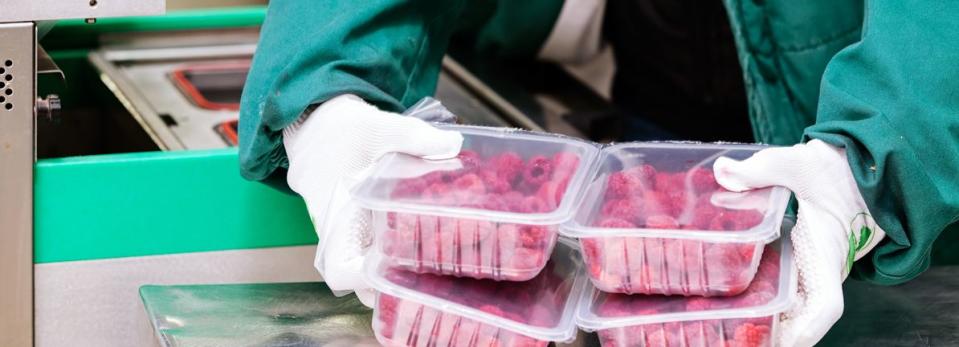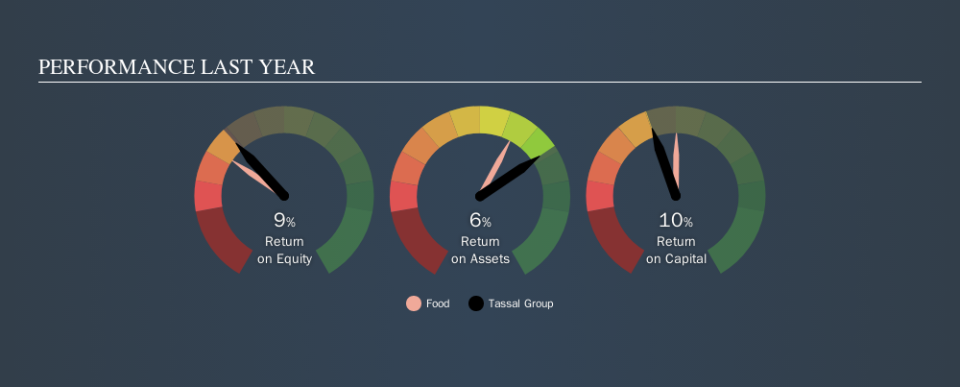A Close Look At Tassal Group Limited’s (ASX:TGR) 9.7% ROCE

Today we are going to look at Tassal Group Limited (ASX:TGR) to see whether it might be an attractive investment prospect. In particular, we'll consider its Return On Capital Employed (ROCE), as that can give us insight into how profitably the company is able to employ capital in its business.
First, we'll go over how we calculate ROCE. Second, we'll look at its ROCE compared to similar companies. Last but not least, we'll look at what impact its current liabilities have on its ROCE.
Understanding Return On Capital Employed (ROCE)
ROCE measures the amount of pre-tax profits a company can generate from the capital employed in its business. Generally speaking a higher ROCE is better. Ultimately, it is a useful but imperfect metric. Renowned investment researcher Michael Mauboussin has suggested that a high ROCE can indicate that 'one dollar invested in the company generates value of more than one dollar'.
So, How Do We Calculate ROCE?
Analysts use this formula to calculate return on capital employed:
Return on Capital Employed = Earnings Before Interest and Tax (EBIT) ÷ (Total Assets - Current Liabilities)
Or for Tassal Group:
0.097 = AU$93m ÷ (AU$1.1b - AU$124m) (Based on the trailing twelve months to June 2019.)
Therefore, Tassal Group has an ROCE of 9.7%.
View our latest analysis for Tassal Group
Does Tassal Group Have A Good ROCE?
ROCE is commonly used for comparing the performance of similar businesses. Tassal Group's ROCE appears to be substantially greater than the 7.2% average in the Food industry. We would consider this a positive, as it suggests it is using capital more effectively than other similar companies. Separate from how Tassal Group stacks up against its industry, its ROCE in absolute terms is mediocre; relative to the returns on government bonds. Readers may find more attractive investment prospects elsewhere.
You can click on the image below to see (in greater detail) how Tassal Group's past growth compares to other companies.
It is important to remember that ROCE shows past performance, and is not necessarily predictive. ROCE can be deceptive for cyclical businesses, as returns can look incredible in boom times, and terribly low in downturns. ROCE is, after all, simply a snap shot of a single year. Since the future is so important for investors, you should check out our free report on analyst forecasts for Tassal Group.
What Are Current Liabilities, And How Do They Affect Tassal Group's ROCE?
Current liabilities include invoices, such as supplier payments, short-term debt, or a tax bill, that need to be paid within 12 months. Due to the way ROCE is calculated, a high level of current liabilities makes a company look as though it has less capital employed, and thus can (sometimes unfairly) boost the ROCE. To counteract this, we check if a company has high current liabilities, relative to its total assets.
Tassal Group has total assets of AU$1.1b and current liabilities of AU$124m. Therefore its current liabilities are equivalent to approximately 11% of its total assets. This is a modest level of current liabilities, which would only have a small effect on ROCE.
The Bottom Line On Tassal Group's ROCE
If Tassal Group continues to earn an uninspiring ROCE, there may be better places to invest. Of course, you might also be able to find a better stock than Tassal Group. So you may wish to see this free collection of other companies that have grown earnings strongly.
If you like to buy stocks alongside management, then you might just love this free list of companies. (Hint: insiders have been buying them).
We aim to bring you long-term focused research analysis driven by fundamental data. Note that our analysis may not factor in the latest price-sensitive company announcements or qualitative material.
If you spot an error that warrants correction, please contact the editor at editorial-team@simplywallst.com. This article by Simply Wall St is general in nature. It does not constitute a recommendation to buy or sell any stock, and does not take account of your objectives, or your financial situation. Simply Wall St has no position in the stocks mentioned. Thank you for reading.

 Yahoo Finance
Yahoo Finance 
